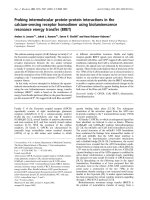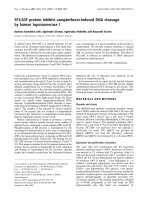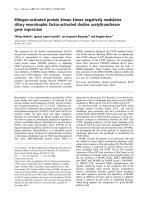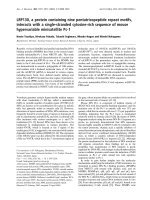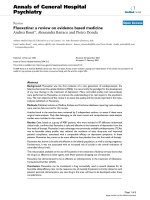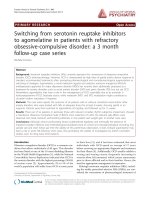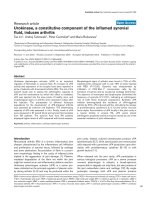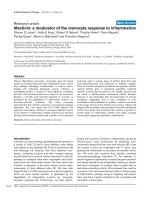Báo cáo Y học: LRP130, a protein containing nine pentatricopeptide repeat motifs, interacts with a single-stranded cytosine-rich sequence of mouse hypervariable minisatellite Pc-1 docx
Bạn đang xem bản rút gọn của tài liệu. Xem và tải ngay bản đầy đủ của tài liệu tại đây (299.61 KB, 7 trang )
LRP130, a protein containing nine pentatricopeptide repeat motifs,
interacts with a single-stranded cytosine-rich sequence of mouse
hypervariable minisatellite Pc-1
Naoto Tsuchiya, Hirokazu Fukuda, Takashi Sugimura, Minako Nagao and Hitoshi Nakagama
Biochemistry Division, National Cancer Center Research Institute, Chuo-ku, Tokyo, Japan
Recently, we have identified and purified minisatellite DNA
binding proteins (MNBPs) that bind to the mouse hyper-
variable minisatellite Pc-1, from NIH3T3 cells. This study
describes the isolation and characterization of a mouse leu-
cine-rich protein (mLRP130) as one of the MNBPs that
binds to the C-rich strand of Pc-1. The mLRP130 cDNA
was demonstrated to encode a polypeptide of 1306 amino-
acid residues with a deduced molecular mass of 137 kDa,
and the mLRP130 mRNA is detected in various organs,
including heart, brain, liver, skeletal muscle, kidneys and
testes. The mLRP130 protein has nine copies of pentatrico-
peptide repeat (PPR) motifs that are considered to serve as
protein–protein interactions. Two forms of the mLRP130
protein were detected in NIH3T3 cells with an approximate
molecular mass of 140 kDa (mLRP130) and 100 kDa
(mLRP130
der
), and were detected mainly in nuclear and
cytoplasmic fractions, respectively. Immunofluorescence
microscopic analysis demonstrated dominant localization
of mLRP130 at the perinuclear region, and also in the
nucleus and cytoplasm with dot- or squiggle-like staining.
The immunoprecipitated mLRP130 bound to the single-
stranded d(CTGCC)
8
, but not to its complementary G-rich
strand of d(GGCAG)
8
or double-stranded form. Possible
biological roles of mLRP130 are discussed in association
with the stability of minisatellite DNA sequences.
Keywords: minisatellite DNA; C-rich sequence; mLRP130;
PPR motif.
Vertebrate genomes contain hypervariable tandem repeats
with short nucleotides (5–100 bp), called a minisatellite
(MN) or variable number of tandem repeat (VNTR) [1,2].
MNs are known to be recombination hot spots in meiotic
cells, but generally stable in somatic cells [3]. However,
alterations of repeat numbers of MNs, MN mutations, were
frequently found in several types of tumors in humans [4–7]
and in experimental animals [8,9], and also in cultured cells
after treatment with various carcinogens, or c- and UV-
irradiations [10–12]. Several MNs have been shown to be
implicated in predisposition to human disorders. The
insulin-VNTR, which is located at the 5¢ region of the
insulin gene (INS), is suggested to be associated with insulin-
dependent diabetes mellitus (IDDM) [13,14]. The expression
of the HRAS1 gene was also affected by the polymorphism
of Ha-ras-VNTR, which lies in the 3¢ downstream region of
the gene, whose mutant alleles are considered to be involved
in the increased risk of cancers [15–18].
Mouse MN Pc-1 is composed of tandem repeats of
d(GGCAG) with locus-specific flanking sequences, and the
mutation rate of the Pc-1 in meiotic cells was 15% per
gamete, while that in somatic cells was 2–3% per population
doubling, indicating that the Pc-1 locus is maintained
relatively stable in somatic cells [19,20]. By means of DNA
fingerprint analysis using the mouse MN Pc-1 fragment as a
probe, we previously demonstrated that MN sequences
become highly unstable in NIH3T3 cells by treatment with
the tumor promoter, okadaic acid, a specific inhibitor of
serine/threonine protein phosphatases, and also in fibroblast
derived from severe combined immunodeficiency (SCID)
mice, in which a catalytic subunit of DNA-dependent
protein kinase (DNA-PKs) is impaired [21,22]. Although
the precise mechanisms for the induction of MN mutations
still remains unresolved, these findings led us to the
possibility that maintenance of MN integrity is partly
regulated by DNA-PK, and changes in the phosphorylation
status in cellular proteins could cause the induction of MN
mutations at Pc-1 or other related loci with repetitive
sequences similar to Pc-1.
In order to gain further insights into the molecular
mechanisms underlying the induction of MN mutations, we
attempted to isolate MN Pc-1 binding proteins, (MNBPs)
from NIH3T3 cells treated with okadaic acid, and six
MNBPs, MNBP-pA, -pB, -pD, -pE, -pF and -pG, have
been isolated [23]. pA and pB bound to the G-rich strand of
the MN Pc-1, d(GGCAG)
8
, which forms an intramolecular
tetraplex structure and causes DNA synthesis arrest in vitro
[24]. Four other proteins, pD, pE, pF and pG, bound to its
complementary C-rich strand [23]. These MNBPs were
Correspondence to H. Nakagama, Biochemistry Division,
National Cancer Center Research Institute, 5-1-1 Tsukiji, Chuo-ku,
Tokyo, 104-0045, Japan.
Fax: + 81 3 3542 2530, Tel.: + 81 3 3547 5239,
E-mail:
Abbreviations: MNBP, minisatellite DNA binding protein; mLRP,
mouse leucine-rich protein; PPR, pentatricopeptide repeat; TPR,
tetratricopeptide repeat; MN, minisatellite; VNTR, variable number
of tandem repeat; IDDM, insulin-dependent diabetes mellitus; SCID,
severe combined immunodeficiency; DNA-PKc, DNA-dependent
protein kinase; DMEM, Dulbecco’s modified Eagle’s medium; WCL,
whole cell lysate; FITC, fluorescein isothiocyanate; EMSA, electro-
phoretic mobility shift assay; PPR, pentatricopeptide repeat.
(Received 22 February 2002, accepted 29 April 2002)
Eur. J. Biochem. 269, 2927–2933 (2002) Ó FEBS 2002 doi:10.1046/j.1432-1033.2002.02966.x
different from previously isolated minisatellite binding
proteins, MSBPs, in their molecular sizes and DNA binding
properties [25–27]. In this study, isolation and character-
ization of a cDNA for one of the C-rich strand binding
MNBP, pE, were carried out. Nucleotide and amino-acid
sequence analyses demonstrated that pE is a partial
fragment of the mouse homologue of human leucine-rich
protein 130 (mLRP130). Another C-rich strand binding
MNBP, pF, was also revealed to be the mLRP130. Human
LRP130 was initially isolated as a highly expressed
transcript from the hepatoblastoma cell line, HepG2 [28].
However, its biological functions, the expression profile of
its mRNA, are still uncharacterized. In this study,
mLRP130 was demonstrated to bind to the C-rich single-
stranded DNA sequences in a sequence-specific manner,
and its biological roles in association with the induction of
MN mutations were discussed.
MATERIALS AND METHODS
Cloning of a cDNA encoding mLRP130
MNBPs were purified from 2 · 10
9
NIH3T3 cells treated
with 7.5 n
M
okadaic acid, as described previously [23]. The
resulting partial polypeptide sequences were determined
according to the methods described by Shinohara et al.[29].
Five polypeptide sequences of C-rich binding MNBP-pE
were determined by Edman degradation under a contract
with APRO Science Co. Ltd (Tokushima, Japan). Database
searches enabled us to determine that pE could be a partial
fragment of the mouse homologue of the human leucine-
rich protein 130, LRP130. Polypeptide sequences of another
C-rich binding MNBP also revealed that pF is a homologue
of LRP130. Therefore, pE and pF were considered to be
encoded by the same gene, and isolation of the full-length
cDNA for pE was carried out as follows. Total RNAs from
NIH3T3 cells were prepared by the method of Chomczynski
& Sacchi using Torizol reagent (Gibco BRL) [30]. One
microgram of total RNA was annealed with an oligo(dT)
primer and the first strand cDNAs were synthesized with
avian myeblastoma virus (AMV) reverse transcriptase
(Takara Biomedicals) at 45 °C for 60 min. Partial cDNA
fragments for the mLRP130 were amplified with a set of
degenerated primers, 5¢-TAT/CTTT/CCAT/CCAA/GT/
CTNC/AGNGA-3¢ and 5¢-GCA/GTCNGCNCG/TT/CT
GCCAA/GTC-3¢, sequences designed from the identified
polypeptide sequences of pF. PCR products were subcloned
into a pCRII (Invitrogen) vector and sequenced. A 1.2-kbp
cDNA fragment, pE Cl 2, had an open reading frame that
included three of five polypeptide sequences determined
from purified pE and two partial peptide sequences
determined from pF. To isolate a full-length mLRP130
cDNA, 2 · 10
6
plaques of an NIH3T3 cDNA library in
kZAP II (Stratagene) were screened by plaque hybridiza-
tion [31] using pE Cl 2 as a probe. A probe was labeled with
[a-
32
P]dCTP (Amersham Pharmacia Biotech) by random
primer labeling as described by Feinberg & Vogelstein [32].
Isolated cDNA clones were subcloned into pBluescript
(Stratagene). Sequence reactions were performed using a
laser dye-labeled primer and Thermo Sequenase DNA
polymerase (Amersham Pharmacia Biotech) by the chain
termination method [31], and nucleotide sequences were
determined on an Li-COR DNA Sequencer (Model 4200).
Alignment of multiple nucleotide sequences and determin-
ation of the consensus sequence were achieved with
GENE-
WORKS
software (Intelligenetics). A homology search of the
databases was performed by the
BLAST
program [33].
Northern blot analysis
Multiple Tissue Northern Blots (Clontech) containing 2 lg
of poly(A)
+
RNA per lane were hybridized with
32
P-labeled
mLRP130 cDNA fragments in a buffer consisting of
6 · NaCl/P
i
/EDTA (1 · NaCl/P
i
/EDTA consists of
150 m
M
NaCl, 10 m
M
NaH
2
PO
4
and 1 m
M
EDTA,
pH 7.4), 50% formamide, 5 · Denhardt’s solution, 0.2%
SDS, 100 lgÆmL
)1
of sonicated and heat-denatured salmon
sperm DNA, at 42 °C for 12 h. cDNA fragments of
mLRP130 of both 5¢ (nucleotides 1–2374), and 3¢ regions
(nucleotides 3174–4388) were labeled as described above.
After hybridization, membranes were washed twice with
2 · NaCl/Cit/0.1% SDS (1 · NaCl/Cit is 15 m
M
sodium
citrate and 150 m
M
NaCl) for 15 min at room temperature,
then with 0.1 · NaCl/Cit/0.1% SDS twice for 30 min at
60 °C, and exposed to X-ray films at )80 °C.
Preparation of polyclonal antibodies
Polyclonal antibodies for both N- and C-terminal regions of
mLRP130 were generated by immunizing rabbits with syn-
thetic peptides selected from deduced amino-acid sequence.
Peptide sequences used for generation of antibodies were as
follows. F-N peptide: VYLQNEYKFSPTDFLAK (amino
acids 84–100), corresponding to an E-1 peptide fragment,
and F-C peptide: TAKNLKLDDLFLKRYA (amino
acids 1258–1273). The IgG fractions were obtained using
protein G Sepharose from the antisera, and were purified
by Sepharose column coupled with each synthetic peptide
used as the immunogen. Eluates were used as aF-N and
aF-C antibodies against N- and C-terminal regions,
respectively.
Immunoblot analysis
Immunoblot analysis was carried out as described previ-
ously [34]. Briefly, cell extracts were loaded and separated
on a 7.5% SDS/polyacrylamide gel, and then transferred to
an immobilon P membrane (Millipore). The membrane was
washed with NaCl/Tris, and incubated with 5% nonfat
skim milk/NaCl/Tris/0.05% Tween 20 (NaCl/Tris/Tween)
for 60 min at 37 °C. The membrane was incubated with
aF-N or aF-C for 12 h at 4 °C. After incubation, the
membrane was washed three times with NaCl/Tris/Tween
and incubated with horseradish peroxidase-conjugated anti-
(rabbit IgG) Ig for 2 h at room temperature. The protein
bands were detected with an ECL plus kit (Amersham
Pharmacia Biotech).
Cell fractionation
Approximately 1 · 10
6
NIH3T3 cells, which were propa-
gated on 10-cm Petri dishes in Dulbecco’s modified Eagle’s
medium (DMEM) supplemented with 10% heat-inactiva-
ted fetal bovine serum, were washed with ice-cold NaCl/P
i
twice, detached by adding 0.25% trypsin, and collected by
centrifugation at 650 g for 10 min. Collected cells were
2928 N. Tsuchiya et al. (Eur. J. Biochem. 269) Ó FEBS 2002
washed with NaCl/P
i
three times, suspended in a 5 cell-pack
vol. of hypotonic buffer, consisting of 10 m
M
Hepes
(pH 7.4), 5 m
M
KCl, 1.5 m
M
MgCl
2
,1m
M
dithiothreitol,
0.2 l
M
phenylmethanesulfonyl fluoride, 3 lgÆmL
)1
leupep-
tin and protease inhibitor cocktail tablets (Roche Molecular
Biochemicals) and centrifuged as above. Final cell pellets
were resuspended in the same volume of hypotonic buffer
and homogenized with a Dounce homogenizer. These
homogenates were used as a whole cell lysate (WCL), and
cytoplasmic and nuclear fractions were further separated by
centrifuging the WCL at 1000 g for 10 min The supernatant
was used as the cytoplasmic fraction, and nuclear pellets
were washed three times with ice-cold NaCl/P
i
to remove
the residual cytoplasmic proteins. An anti-(a-tubulin) Ig
(ICN Biomedicals) was used to visualize a-tubulin, which is
a marker for the cytoplasmic fraction.
Indirect immunofluorescence microscopy
NIH3T3 cells grown on a collagen type I coated dish (Aashi
Techno Glass) were washed with NaCl/P
i
and fixed with
prechilled methanol at )20 °C for 20 min. Cells were first
treated with an antibody, aF-N or normal rabbit IgG, then
incubated at room temperature for 60 min, and further
incubated with fluorescein isothiocyanate (FITC)-conjugat-
ed anti-(rabbit IgG) Ig as the secondary antibody for
60 min, then mounted with 80% glycerol containing 2.5%
of 1,4-diazabicyclo-(2,2,2)-octane. Cells were examined by
fluorescence microscopy (Olympus).
Immunoprecipitation
To prepare cell extracts, 1 · 10
7
NIH3T3 cells were
harvested and washed with NaCl/P
i
, lysed with a 5 cell-
pack vol. of lysis buffer consisting of 50 m
M
Tris/HCl
(pH 8.0), 140 m
M
NaCl, 1 m
M
EDTA, 1 m
M
EGTA,
1m
M
dithiothreitol, 0.2 l
M
phenylmethanesulfonyl fluor-
ide, 3 lgÆmL
)1
leupeptin and 1% NP-40, and rotated at
4 °C for 1 h. For immunoprecipitation, 5 lgofaF-N, or
normal rabbit IgG as a negative control, were added to
200 lL of cell extract prepared as described above. Samples
were incubated at 4 °C for 2 h and further incubated for 1 h
with 50 lL of 50% slurry of protein A Sepharose. After
washing with the lysis buffer, immunoprecipitates were
eluted from protein A Sepharose by adding the F-N peptide
at a concentration of 20 ngÆlL
)1
, and an aliquot of eluate
was used for electrophoretic mobility shift assay.
Electrophoretic mobility shift assay (EMSA)
DNA-binding activities of mLRP130 were analyzed by
EMSA as described previously [35]. The single-stranded
oligonucleotide sequences used for EMSA are as follows;
C8: 5¢-dGAT(CTGCC)
8
-3¢,C5:5¢-d(CTGCC)
5
-3¢,C5-Pc-2:
5¢-d(CCTGCC)
5
-3¢,C5-gg:d(CGGCC)
5
-3¢,G8:5¢-dTCG
(GGCAG)
8
-3¢. C5gg has single base substitutions, T fi G,
in the repeat sequence of C5. DS12 is a double-stranded
form of d(GGCAG)
12
[24]. Single-stranded oligonucleotides
were end-labeled with [c-
32
P]ATP by T4 polynucleotide
kinase, and a double-stranded oligonucleotide was labeled
with [a-
32
P]dCTP by fill-in reaction with a Klenow fragment
[31]. The standard reaction mixture (10 lL) contained 2 lL
of 5 · binding buffer (50 m
M
Tris/HCl, pH 7.5, 500 m
M
KCl, 5 m
M
dithiothreitol, 1 m
M
EDTA, 1 mgÆmL
)1
BSA
and 38% glycerol), 10 m
M
MgCl
2
, 100–500 fmol of a
labeled probe and 2 lL of eluate, as described above. These
mixtures were incubated at 25 °C for 20 min, and the
reaction was stopped by adding 2 lL of dye solution,
composed of 0.25% bromophenol blue, 0.25% xylene
cyanol and 30% glycerol. DNA–protein complexes were
separated on an 8% nondenaturing polyacrylamide gel in
0.5 · Tris/borate/EDTA buffer (45 m
M
Tris/borate,
pH 8.0, and 1 m
M
EDTA), and analyzed with a Bio-Image
Analyzer, BAS2000 (Fuji Photo Film).
RESULTS
Isolation of mLRP130 cDNA
To isolate cDNA for the 100 kDa MNBP-pE, large-scale
purification of the pE was performed as described previ-
ously [23], and five polypeptide sequences were determined.
These sequences showed high homology with the internal
amino-acid sequences of human LRP130. Unexpectedly,
polypeptide sequences of another MNBP, pF, also showed
high homology to the internal amino-acid sequences of
human LRP130, although none of the analyzed peptides of
pE and pF were the same. These results guided us to the
possibility that pE and pF were produced from the same
gene. Thus, cloning of mouse LRP130 (mLRP130) cDNA
was carried out by using the sequence informations of both
pE and pF, as described in Materials and methods. A
1.2-kbp partial cDNA fragment, pE Cl 2, whose deduced
amino-acid sequence included three of five determined
peptide sequences, E-3, E-4 and E-5, was isolated by
RT-PCR using a degenerated primer set designed from pF
polypeptide sequences, F-1 and F-2 (underlined in Fig. 1).
Furthermore, a total of 26 cDNA clones were isolated by
screening of an NIH3T3 cDNA library using pECl2 as a
probe, and the complete nucleotide sequence was deter-
mined by sequencing three overlapping clones. The entire
cDNA, being 4571 bp in size, contained an ORF of 3918 bp
between nucleotides 471 and 4388. A polyadenylated signal
was noted at nucleotides 4540–4545, and an in-frame
upstream stop codon located at nucleotides 453–455 (data
not shown). The nucleotide sequence of the mLRP130 will
appear in GenBank/EMBL/DDBJ with the accession
number AB027124. As shown in Fig. 1, the coding region
encodes a protein of 1306 amino-acid residues with a
deduced molecular mass of 137 kDa. Five (E-1 to E-5) and
two (F-1 and F-2) polypeptide sequences derived from pE
and pF, respectively, are indicated in Fig. 1. These results
suggested the possibility that pF is a full length mLRP130,
and pE is produced by cleavage of the C-terminal region of
mLRP130. The amino-acid sequence of mLRP130 showed
75.2% identity to human LRP130 (data not shown).
Furthermore, a unique structural motif called a pentatrico-
peptide repeat (PPR) motif, a 35 amino-acid sequence found
in plant and yeast proteins [36], was dispersed nine times
throughout the entire protein (boxed in Fig. 1).
Expression of mLRP130 mRNA
No expression of LRP130 mRNA has been previously
reported in rat normal tissues using human cDNA as a
probe [28]. To clarify the expression of mLRP130 mRNA in
Ó FEBS 2002 Single-stranded C-rich DNA binding protein, LRP130 (Eur. J. Biochem. 269) 2929
mouse tissue, Northern blot analysis of various organs of
mice was performed using 5¢ region of mLRP130 cDNA as
a probe. A single species of 4.7 kb mRNA was expressed
strongly in heart, liver, and kidneys, and weakly in brain,
skeletal muscle and testes, and not detectable in spleen and
lungs. The mLRP130 mRNA was also detected, but weakly,
in all the embryonal stages examined, and a slight increase
was observed in accordance with the embryonal develop-
ment (Fig. 2). Hybridization with the 3¢ probe produced the
same results (data not shown).
Subcellular localization of mLRP130 in NIH3T3 cells
Nuclear and cytoplasmic fractions were prepared from
NIH3T3 cells and analyzed by immunoblot analysis. As
shown in Fig. 3A, a major band with a molecular mass of
140 kDa was detected by aF-N in WCL (lane 1), as well
as a minor band of 100 kDa. The size of the former was
almost equivalent to the predicted molecular mass of
mLRP130 (137 kDa). The smaller molecular mass protein,
which was tentatively named as mLRP130 derivative
(mLRP130
der
), was detected in the cytoplasmic fraction
(Fig. 3A, lane 2). In contrast, mLRP130 was found in the
nuclear fraction by aF-N (lane 3) and aF-C (lane 6).
Interestingly, mLRP130
der
(a shorter sequence) was not
detected by aF-C (lanes 4 and 5), suggesting it may be the
C-terminal truncated form of mLRP130. Coincidentally,
thesizeofmLRP130
der
was equivalent to that of pE [23],
and both mLRP130 and mLRP130
der
were found to bind
to single-stranded C-rich sequence, C8, by South-Western
analysis (data not shown). Taken together, the available
data suggest that mLRP130
der
and mLRP130 may
correspond to pE and pF, respectively. In addition, a
band with a molecular mass of 140 kDa was detected
by aF-C in the cytoplasmic fraction (lane 5). Another
isoform of mLRP130, having a different N-terminal
region, could be present in NIH3T3 cells. Further studies
should be conducted to exclude the possibility that
a different species cross-reacted with aF-C specifically
or nonspecifically.
Subcellular localization of mLRP130 in NIH3T3 cells
was also analyzed immunohistochemically using aF-N
(Fig. 3B). Strong staining of mLRP130 was detected at
the perinuclear region, and also in the cytoplasm with dot-
or squiggle-like staining pattern. Weaker staining was also
observed in nuclei. A similar staining pattern was not
observed by normal rabbit IgG (data not shown).
MLRP130 binds to the single-stranded
C-rich sequence of MN Pc-1
Cell fractionation analysis suggested that the full-length
mLRP130 functions within nuclei. To analyze the DNA
binding activity of cellular mLRP130, immunoprecipita-
tion was performed using aF-N. As shown in Fig. 4A, the
mLRP130 was detected in the immunoprecipitated frac-
tion by aF-N (lane 3), but not by normal rabbit IgG
(lane 2). The same band was also detected by aF-C in the
immunoprecipitated fraction by aF-N (Fig. 4A, lower
panel, lanes 3). The precipitate of mLRP130
der
was hardly
detectable by aF-N, and the DNA-binding activity of
mLRP130 was carried out using immunoprecipitated
mLRP130 as follows: mLRP130 was eluted from the
immunoprecipitated fraction by incubation with F-N
peptide, as described in Materials and methods. Aliquots
of eluate were subjected to EMSA to determine DNA
binding activity using C8, G8 and DS12 probes. A DNA–
mLRP130 complex was formed with the single-stranded
C-rich sequence, C8 (Fig. 4B, lane 3). The DNA–protein
complex was not detected by the single-stranded G-rich
sequence, G8, and double-stranded form, DS12 (lanes 6
Fig. 2. Expression of mLRP130 mRNA. Left and right panels are
Northern blots for mouse normal tissues and embryonal stages,
respectively. Northern blots containing 2 lg of poly(A)
+
RNA per
lane were analyzed by hybridization with the 5¢ region of
32
P-labeled
mLRP130 cDNA as described in Materials and methods. Arrowheads
indicate a band of 4.7-kb mLRP130 mRNA. The molecular sizes are
indicated on the left of each panel.
Fig. 1. Deduced amino-acid sequence of mLRP130. The amino-acid
sequence of mLRP130 was deduced from its cDNA sequence, and
numbered on the right. Peptide sequences, E-1 to E-5, determined from
purified pE, and, F-1 and F-2, from pF are indicated bold italic letters.
Nine PPR motifs found in mLRP130 are boxed. A 1.2-kb pE Cl2
initially isolated by RT-PCR is underlined. Peptide sequences used for
the generation of antibodies are dotted on the sequences.
2930 N. Tsuchiya et al. (Eur. J. Biochem. 269) Ó FEBS 2002
and 9). No DNA–protein complex was detected using
eluate of the immunoprecipitate by normal rabbit IgG
(lanes 2, 5 and 8).
Sequence specificity for DNA binding
Sequence specificity of mLRP130 for DNA binding was
analyzed using various oligonucleotides as competitors. The
DNA–protein complex was formed by incubation of
mLRP130 with a
32
P-labeled C8 probe (Fig. 5, lane 3).
Formation of this complex was undetectable when a 10-fold
molar excess of unlabeled C8 was added (lane 4). C5 Pc-2
demonstrated a similar binding activity to C8 (lanes 10–12).
In contrast, the binding activity to C5 is 10-fold less
than that of C8 and C5Pc-2 (lanes 7–9). No binding was
observed with C5gg or poly(dA) (lanes 13–15 and 16–18,
respectively).
DISCUSSION
This study described the cloning and characterization of a
cDNA encoding a mLRP130 from NIH3T3 cells as a C-rich
binding MNBP. We have previously identified four C-rich
binding MNBPs from the nuclear extract of NIH3T3 cells,
Fig. 3. Subcellular localization of mLRP130 in NIH3T3 cells. (A) Cell fractionation analysis. Left and right panels indicate the immunoblot analysis
using aF-N and aF-C, respectively. The positions of the protein standard are indicated on the left. Closed and open arrowheads show the bands of
mLRP130 and mLRP130
der
, respectively. a-tubulin was used as a marker for cytoplasmic extraction. The same membrane was used for immunoblot
analysis with aF-N, aF-C and anti-(a-tubulin) Ig. Lanes 1 and 4, whole cell lysate; lanes 2 and 5, cytoplasmic fraction; lanes 3 and 6, nuclear
fraction. (B) Indirect immunofluorescence microscopy. NIH3T3 cells were fixed with prechilled methanol and labeled with aF-N, and then
visualized with FITC conjugated anti-(rabbit IgG) Ig as a secondary antibody. Cells were examined with fluorescence microscopy (·40).
Fig. 4. mLRP130 binds to the single-stranded C-rich sequence of MN
Pc-1. (A) Upper and lower panels are immunoblot analyses using
aF-N and aF-C following immunoprecipitation of cell extracts from
NIH3T3 cells using a aF-N or normal rabbit IgG as a control, res-
pectively. Positions of protein molecular weight marker (Bio-Rad) are
shown on the left of each panel. Closed and open arrowheads indicate
the mLRP130 and mLRP130
der
bands, respectively. Lane 1, cell
extract; lane 2, immunoprecipitant (ipp)withnormalrabbitIgG;lane
3, ipp with aF-N. (B) EMSA using immunoprecipitated mLRP130.
32
P-Labeled probes (C8, G8 and DS12) were incubated with
mLRP130, and the DNA-protein complex was analyzed by EMSA as
described in Materials and methods. Arrowheads indicate a DNA–
protein complex and each unbound probe, respectively. Lanes 1–3, 4–6
and 7–9 were results of EMSA with C8, G8 and DS12 probes,
respectively. Lanes 1, 4 and 7, without protein; lanes 2, 5 and 8, ipp
with normal rabbit IgG; lanes 3, 6 and 9, ipp with aF-N.
Fig. 5. DNA binding activities of mLRP130 in the presence of various
oligonucleotides. Immunoprecipitated mLRP130 and
32
P-labeled C8
were incubated with or without various concentrations of unlabeled
oligonucleotides, and the DNA-protein complex was analyzed by
EMSA. Three concentrations, 10-, 50- and 100-fold molar excess of
unlabeled competitors, are indicated at the top. Arrowheads show a
DNA–protein complex and unbound probe, respectively. Lane 1,
without protein; lane 2, ipp with normal rabbit IgG; lane 3, ipp with
aF-N without competitors; and with competitors, lanes 4, 5 and 6, with
C8; lanes 7, 8 and 9, with C5; lanes 10, 11 and 12, with C5Pc-2; lanes
13, 14 and 15, with C5gg; lanes 16, 17 and 18, with poly(dA).
Ó FEBS 2002 Single-stranded C-rich DNA binding protein, LRP130 (Eur. J. Biochem. 269) 2931
and two of them, pE and pF, have a molecular mass of 100
and 130 kDa, respectively [23]. An amino-acid sequence of
mLRP130 contained all of the peptide sequences of pE and
pF. Furthermore, mLRP130 shows the same DNA binding
properties to that of the previously characterized pE [23].
We therefore hypothesized that pE and pF are mLRP130
der
and mLRP130, respectively, the former representing a
truncated form of the C-terminal region produced by post-
translational processing. However, more detailed studies,
including determination of the cleavage site of the
mLRP130 and analysis of the DNA binding activity of
the cleaved form, are needed to confirm that mLRP130
der
and pE is the same protein produced by processing of
mLRP130.
Subcellular localization of mLRP130 was analyzed by
immunofluorescence microscopy and cell fractionation
analysis. The localization of mLRP130 is remarkable at
the perinuclear region, with some in the nuclei, and in the
cytoplasm with dot- and squiggle-like staining patterns. The
cytoplasmic staining is likely to be ascribed to mLRP130
der
,
from cell fractionation analysis, and its association with
cytoplasmic structural protein or organelles could be
suggested. This is one of the possible explanations why
mLRP130
der
was not immunoprecipitated efficiently by
aF-N. On the other hand, mLRP130 was detected mainly in
the nuclear fraction. The different subcellular localization of
mLRP130 and mLRP130
der
may reflect the distinct biolo-
gical functions of this protein between nuclei and cytoplasm.
Human LRP130 was first identified in the hepatoblastoma
cell line HepG2 as a highly expressed transcript [28], and its
expression was detected strongly in liver as well as heart and
kidneys examined in this study. The mLRP130 contains
nine copies of PPR motifs, and the first four PPR motifs lie
at the N-terminal region in tandem. Compositions of
amino-acid residues and the predicted secondary structure
of the PPR motif are very similar to that of the tetratrico-
peptide repeat (TPR) motif [36]. TPR motifs are presented
in a variety of proteins with variable repeat numbers, and
are known to be essential motifs for protein–protein
interaction in, for example, some phosphatases or cell cycle
regulated proteins [37]. PPR motifs could also take the
tertiary structure similar to that of TPR motifs, and serve as
a protein–protein interaction domain of mLRP130. Iden-
tification of proteins interacting with the PPR motifs is to be
conducted in future experiments to clarify the biological
functions of PPR motifs in mLRP130.
In vitro DNA binding assay showed that immunopre-
cipitated mLRP130 binds to single-stranded C-rich
sequence of MN Pc-1, but not to its complementary
sequence. Although the possibility that the immunopre-
cipitated fraction contains mLRP130 interacting proteins
could not be completely excluded, no other protein bands
were detected in the immunoprecipitated fraction when
stained with Coomassie Brilliant Blue after SDS/PAGE
analysis (data not shown). Therefore, DNA binding
activity is attributed to the presence of mLRP130 itself.
mLRP130 did not bind to the double-stranded form, or to
C5gg, indicating that mLRP130 binds to the single-
stranded C-rich sequence in a sequence-dependent man-
ner. These results led us to the hypothesis that mLRP130
efficiently binds to the single-stranded region of repetitive
sequences composed of d(CCTXCC)
n
.Furthermore,it
appears to be likely that a long C-rich sequence or a long
tandem repeat allele was required for the DNA binding
activity of mLRP130. It has been known that G-rich
repetitive sequences, including telomere and insulin–
VNTR, form the unusual DNA structure like G-quartet
[38,39]. Additionally, formation of the I-tetraplex structure
by the C-rich strand of the telomere and insulin-VNTR
has also been reported [38,40]. Recently, we have reported
that the G-rich sequence of MN Pc-1 forms an intra-
molecular G-quartet structure, and DNA synthesis arrests
at repeat sequences in vitro [24]. These unusual structures
might be one of the dominant causes for induction of MN
mutations. Although the biological functions of mLRP130
could not be fully elucidated, its binding to the single-
stranded C-rich region of chromosomes, which is exposed
by formation of the unusual structure of its complement-
ary G-rich strand, could affect the stability of G-rich
repetitive sequence loci.
ACKNOWLEDGEMENTS
This work was supported by Grant-in Aid for Cancer Research from
the Ministry of Health, Labour and Welfare of Japan, by Grant-in Aid
from the Ministry of Education, Culture, Sports, Science and
Technology of Japan. Peptide synthesis and production of peptide
antibodies was carried out by IBL Co. Ltd. N. T. is a recipient of
Research Resident Fellowship from Foundation for Promotion of
Cancer Research in Japan.
REFERENCES
1. Jeffreys, A.J., Wilson, V. & Thein, S.L. (1985) Hypervariable
ÔminisatelliteÕ regions in human DNA. Nature 314, 67–73.
2. Jeffreys, A.J. (1987) Highly variable minisatellites and DNA
fingerprints. Biochem. Soc. Trans. 15, 309–317.
3. Jeffreys, A.J., Tamaki, K., MacLeod, A., Monckton, D.G., Neil,
D.L. & Armour, J.A. (1994) Complex gene conversion events in
germline mutation at human minisatellites. Nat. Genet. 6, 136–145.
4. Thein, S.L., Jeffreys, A.J., Gooi, H.C., Cotter, F., Flint, J.,
O’Connor, N.T., Weatherall, D.J. & Wainscoat, J.S. (1987)
Detection of somatic changes in human cancer DNA by DNA
fingerprint analysis. Br. J. Cancer 55, 353–356.
5. Honma, M., Kataoka, E., Ohnishi, K., Kikuno, T., Hayashi, M.,
Sofuni, T. & Mizusawa, H. (1993) Detection of recombinational
mutations in cultured human cells by Southern blot analysis with
minisatellite DNA probes. Mutat. Res. 286, 165–172.
6. Boltz,E.M.,Harnett,P.,Leary,J.,Houghton,R.,Kefford,R.F.&
Friedlander, M.L. (1990) Demonstration of somatic rearrange-
ments and genomic heterogeneity in human ovarian cancer by
DNA fingerprinting. Br. J. Cancer 62, 23–27.
7. Matsumura, Y. & Tarin, D. (1992) DNA fingerprinting survey of
various human tumors and their metastases. Cancer Res. 52, 2174–
2179.
8. Ledwith, B.J., Storer, R.D., Prahalada, S., Manam, S., Leander,
K.R., van Zwieten, M.J., Nichols, W.W. & Bradley, M.O. (1990)
DNA fingerprinting of 7,12-dimethylbenz[a]anthracene-induced
and spontaneous CD-1 mouse liver tumors. Cancer Res. 50, 5245–
5249.
9. Ledwith, B.J., Joslyn, D.J., Troilo, P., Leander, K.R., Clair, J.H.,
Soper, K.A., Manam, S., Prahalada, S., van Zwieten, M.J. &
Nichols, W.W. (1995) Induction of minisatellite DNA rearrange-
ments by genotoxic carcinogens in mouse liver tumors. Carcino-
genesis 16, 1167–1172.
10. Suzuki, K., Takada, T., Sugawara, Y., Muto, T. & Kominami, R.
(1991) Quercetin induced recombinational mutations in cultured
cellsasdetectedbyDNAfingerprinting.Jpn J. Cancer Res. 82,
1061–1064.
2932 N. Tsuchiya et al. (Eur. J. Biochem. 269) Ó FEBS 2002
11. Paquette, B. & Little, J.B. (1992) Genomic rearrangements in
mouse C3H/10T1/2 cells transformed by X-ray, UV-C, and
3-methylcholanthrene, detected by a DNA fingerprint assay.
Cancer Res. 52, 5788–5793.
12. Kitazawa, T., Kominami, R., Tanaka, R., Wakabayashi, K. &
Nagao, M. (1994) 2-Hydroxyamino-1-methyl-6-phenylimidazo-
[4,5,-b]pyridine induction of recombinational mutations in mam-
malian cells as detected by DNA fingerprinting. Mol. Carcinog. 9,
67–70.
13. Bell, G.I., Selby, M.J. & Rutter, W.J. (1982) The highly poly-
morphic region near the human insulin gene is composed of simple
tandem repeating sequences. Nature 295, 31–35.
14. Bennett, S.T., Wilson, A.J., Cucca, F., Nerup, J., Pociot, F.,
McKinney, P.A., Barnett, A.H., Bain, S.C. & Todd, J.A. (1996)
IDDM2-VNTR-encoded susceptibility to type 1 diabetes: domi-
nant protection and parental transmission of alleles of the insulin
gene-linked minisatellite locus. J. Autoimmun. 9, 415–421.
15. Green, M. & Krontiris, T.G. (1993) Allelic variation of reporter
gene activation by the HRAS1 minisatellite. Genomics 17, 429–
434.
16. Krontiris, T.G. (1995) Minisatellites and human disease. Science
269, 1682–1683.
17. Krontiris, T.G., Devlin, B., Karp, D.D., Robert, N.J. & Risch, N.
(1993) An association between the risk of cancer and mutations in
the HRAS1 minisatellite locus. N. Engl. J. Med. 329, 517–523.
18. Phelan, C.M., Rebbeck, T.R., Weber, B.L., Devilee, P., Ruttledge,
M.H., Lynch, H.T., Lenoir, G.M., Stratton, M.R., Easton, D.F.,
Ponder, B.A. et al. (1996) Ovarian cancer risk in BRCA1 carriers is
modified by the HRAS variable number of tandem repeat
(VNTR) locus. Nat. Genet. 12, 309–311.
19. Mitani, K., Takahashi, Y. & Kominami, R. (1990) A GGCAGG
motifs in minisatellites affecting their germline instability. J. Biol.
Chem. 265, 15203–15210.
20. Suzuki, S., Mitani, K., Kuwabara, K., Takahashi, Y., Niwa, O. &
Kominami, R. (1993) Two mouse hypervariable minisatellites:
chromosomal location and simultaneous mutation. J. Biochem.
114, 292–296.
21. Nakagama,H.,Kaneko,S.,Shima,H.,Inamori,H.,Fukuda,H.,
Kominami, R., Sugimura, T. & Nagao, M. (1997) Induction of
minisatellite mutation in NIH3T3 cells by treatment with the
tumor promoter okadaic acid. Proc. Natl Acad. Sci. USA 94,
10813–10816.
22. Imai, H., Nakagama, H., Komatsu, K., Shiraishi, T., Fukuda, H.,
Sugimura, T. & Nagao, M. (1997) Minisatellite instability in severe
combined immunodeficiency mouse cells. Proc. Natl Acad. Sci.
USA 94, 10817–10820.
23. Fukuda, H., Sugimura, T., Nagao, M. & Nakagama, H. (2001)
Detection and isolation of minisatellite Pc-1 binding proteins.
Biochim. Biophys. Acta, 152 p, 152–158.
24. Katahira, M., Fukuda, H., Kawasumi, H., Sugimura, T.,
Nakagama, H. & Nagao, M. (1999) Intramolecular quadruplex
formation of the G-rich strand of the mouse hypervariable
minisatellite Pc-1. Biochem. Biophys. Res. Commun. 264, 327–333.
25. Collick, A., Dunn, M.G. & Jeffreys, A.J. (1991) Minisatellite
binding protein Msbp-1 is a sequence-specific single-stranded
DNA-binding protein. Nucleic Acids Res. 19, 6399–6404.
26. Wahls, W.P., Swenson, G. & Moore, P.D. (1991) Two hyper-
variable minisatellite DNA binding proteins. Nucleic Acids Res.
19, 3269–3274.
27. Yamazaki, H., Nomoto, S., Mishima, Y. & Kominami, R.
(1992) A 35-kDa protein binding to a cytosine-rich strand of
hypervariable minisatellite DNA. J. Biol. Chem. 267, 12311–
12316.
28. Hou, J., Wang, F. & McKeehan, W.L. (1994) Molecular cloning
and expression of the gene for a major leucine-rich protein from
human hepatoblastoma cells (HepG2). In Vitro Cell. Dev. Biol.
30A, 111–114.
29. Shinohara, Y., Sagawa, I., Ichihara, J., Yamamoto, K., Terao, K.
& Terada, H. (1997) Source of ATP for hexokinase-catalyzed
glucose phosphorylation in tumor cells: dependence on the rate of
oxidative phosphorylation relative to that of extramitochondrial
ATP generation. Biochim. Biophys. Acta 1319, 319–330.
30. Chomczynski, P. & Sacchi, N. (1987) Single-step method of RNA
isolation by acid guanidinium thiocyanate-phenol-chloroform
extraction. Anal. Biochem. 162, 156–159.
31. Sambrook, J., Fritsch, E.F. & Maniatis, T. (1989) Molecular
Cloning. A Laboratory Manual, 2nd edn. Cold Spring Harbor
Laboratory Press, Cold Spring Harbor, NY.
32. Feinberg, A.P. & Vogelstein, B. (1983) A technique for radio-
labeling DNA restriction endonuclease fragments to high specific
activity. Anal. Biochem. 132, 6–13.
33. Altschul, S.F., Gish, W., Miller, W., Myers, E.W. & Lipman, D.J.
(1990) Basic local alignment search tool. J. Mol. Biol. 215,
403–410.
34. Towbin,H.,Staehelin,T.&Gordon,J.(1979)Electrophoretic
transfer of proteins from polyacrylamide gels to nitrocellulose
sheets: procedure and some applications. Proc. Natl Acad. Sci.
USA 76, 4350–4354.
35. Carthew, R.W., Chodosh, L.A. & Sharp, P.A. (1985) An RNA
polymerase II transcription factor binds to an upstream element in
the adenovirus major late promoter. Cell 43, 439–448.
36. Small, I.D. & Peeters, N. (2000) The PPR motif – a TPR-related
motif prevalent in plant organellar proteins. Trends Biochem. Sci.
25, 46–47.
37. Blatch, G.L. & Lassle, M. (1999) The tetratricopeptide repeat: a
structural motif mediating protein–protein interactions. Bioessays
21, 932–939.
38. Rhodes, D. & Giraldo, R. (1995) Telomere structure and function.
Curr. Opin. Struct. Biol. 5, 311–322.
39. Catasti, P., Chen, X., Moyzis, R.K., Bradbury, E.M. & Gupta, G.
(1996) Structure–function correlations of the insulin-linked poly-
morphic region. J. Mol. Biol. 264, 534–545.
40. Catasti, P., Chen, X., Deaven, L.L., Moyzis, R.K., Bradbury,
E.M. & Gupta, G. (1997) Cystosine-rich strands of the insulin
minisatellite adopt hairpins with intercalated cytosine+.cytosine
pairs. J. Mol. Biol. 272, 369–382.
Ó FEBS 2002 Single-stranded C-rich DNA binding protein, LRP130 (Eur. J. Biochem. 269) 2933
